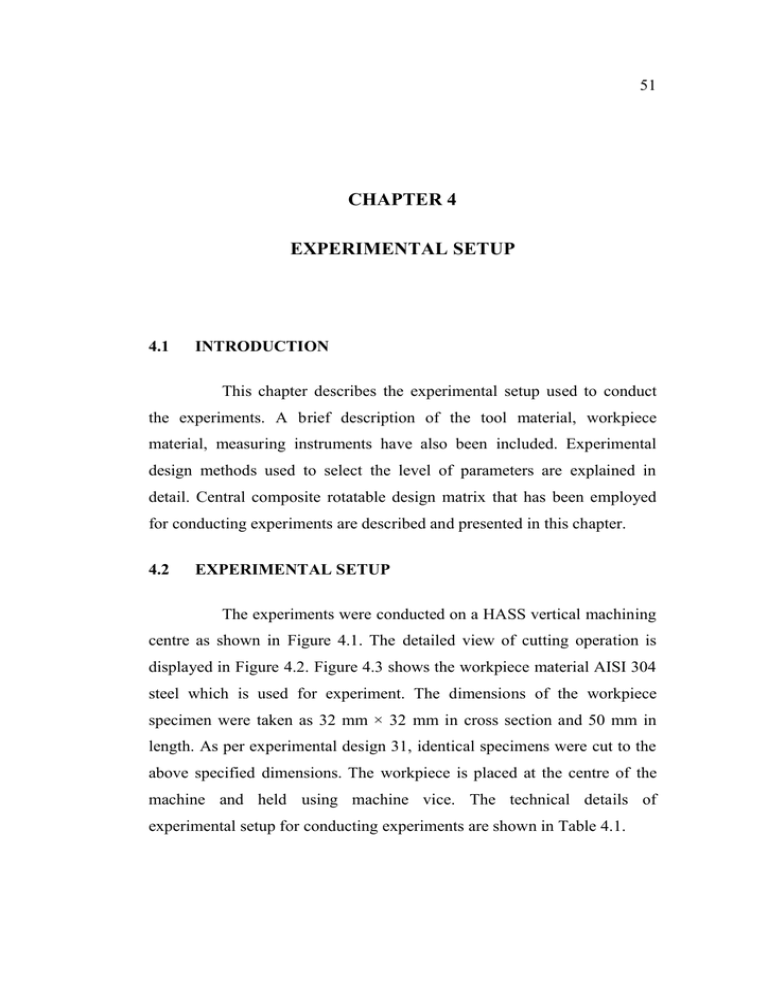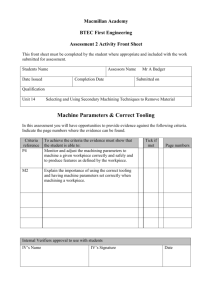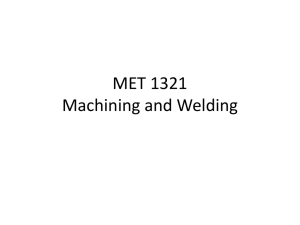Experimental Setup in Machining: AISI 304 Steel
advertisement

51 CHAPTER 4 EXPERIMENTAL SETUP 4.1 INTRODUCTION This chapter describes the experimental setup used to conduct the experiments. A brief description of the tool material, workpiece material, measuring instruments have also been included. Experimental design methods used to select the level of parameters are explained in detail. Central composite rotatable design matrix that has been employed for conducting experiments are described and presented in this chapter. 4.2 EXPERIMENTAL SETUP The experiments were conducted on a HASS vertical machining centre as shown in Figure 4.1. The detailed view of cutting operation is displayed in Figure 4.2. Figure 4.3 shows the workpiece material AISI 304 steel which is used for experiment. The dimensions of the workpiece specimen were taken as 32 mm × 32 mm in cross section and 50 mm in length. As per experimental design 31, identical specimens were cut to the above specified dimensions. The workpiece is placed at the centre of the machine and held using machine vice. The technical details of experimental setup for conducting experiments are shown in Table 4.1. 52 Table 4.1 Technical details of experimental setup Parameter Value Power of spindle motor 5.6 kw Speed range of spindle motor 0 - 4000 rpm Feed rate (F) m/mm 5.1 m/mm Torque of spindle and feed motor 45 Nm @ 1200 rpm Feed (X & Y dir) 0 - 450 mm/min Machine tool Hass vertical machining centre TM1 Machine weight 1470 kg Material of cutter Uncoated solid carbide end-mill Number of flutes 4 Diameter of cutter 12 mm Axial rack angle of cutter 18° Nose radius 0.4 mm Size of the workpiece 32 × 32 × 50 mm Radial depth of the cut 2.5 mm Workpiece material AISI 304 steel Surface roughness measuring Mitutoya SJ-201 surf instrument tester @ 28±1 C Tool wear measuring instrument microscope Cutting force measuring Syscon tool instrument dynamometer 53 Figure 4.1 Figure 4.2 HASS vertical machining centre A detailed view of end-mill and workpiece setup 54 Figure 4.3 Workpiece material (AISI 304 steel) The tool material used was the uncoated solid carbide tools. Solid carbide tool is inexpensive when compared to other tool materials. It can be easily shaped and contains excellent fracture toughness, fatigue and shock resistance. Five end-mill cutters with different helix angles have been utilized for conducting experiments, as shown in Figure 4.4. The shank type end-mill is available in wide variety of sizes, flute configurations and lengths. The specifications of geometry of the end-mill used for conducting experiments are as follows: (i) Number of flutes 4 (ii) Diameter of cutter 12 mm (iii) Shank length 70 mm (iv) Rake angle of flute 12° (v) Helix angle of flutes 25°, 30°, 35°, 40° & 45°. (vi) Coating type Uncoated 55 25 Figure 4.4 4.3 30 35 40 45 End-mill cutters with different helix angles SURFACE ROUGHNESS MEASUREMENT PRINCIPLE The average roughness value was measured using Mitutoyo Surftest SJ201 as shown in the Figure 4.5. The Surftest SJ201 is a shop floor type surface roughness-measuring instrument, which traces the surface of various machine parts, calculates their roughness standards, and displays the result. The measuring instruments consist of a detector unit with stylus for tracing. A pickup or stylus of the detector unit will trace the minute irregularities of the workpiece surface. The vertical stylus displacement produced during tracing the work surface is converted into an electrical signal. The electrical signals are subjected to various calculation processes and the results of calculations (measurement result) are displayed on the instrument liquid crystal display. RS 232 port is available in the instruments to acquire the measured surface roughness value using Mituotyo version 3.0 software. The cut-off length used during the measurement was 2.5 mm and the measurement were taken at three places 56 on the machined surface and the averages of those values were noted. The certificates of inspection of the measured values are attached in Appendix III. 4.3.1 Mituotyo Surface Test SJ201 The range and features of Mitutoyo SJ 201 P are presented below: Portable for easy measurement The detector/drive unit can be detached from the display unit for effortless measurement Contain wide 350 µm (-200 µm to + 150 µm) measurement range Can be auto-calibrated 10 Measurement data can be retained in memory even after the power is turned off RS-232C interface enables data transfer to computer or other devices using an external device A dedicated carrying case is included for safe transport 57 Figure 4.5 Mitutoyo SJ-201 setup for surface roughness measurement 4.4 TOOL WEAR The tool wear was measured using Metzer tool microscope on the flank surface of the end-mill cutter specimen as shown in Figure 4.6. The tool makers microscope consist of 150 mm × 150 mm measuring stage, travel of 25 mm and extendable up to 50 mm with slip gauges, Gonimeter eyepieces 10X with scale, base illumination (diascopic) 12V/20W (variable intensity) incident illumination 12V/20W (variable intensity), Magnification 30X with field of view 12 mm and working distance 80 mm. The tool after milling is kept in the measuring stage. The tool wear is measured on the flank surface with the help of vernier scale and cross wire. 58 Figure 4.6 measurement 4.5 CUTTING FORCE The cutting forces such as infeed force, crossfeed force and thrust force are measured using syscon instruments milling tool dynamometer. The instruments work based on the strain gauge wheat-stone bridge principle. RS232 port is available in the instruments to acquire data while machining. The workpiece is mounted on the specially-designed machine with strain gauges to measure the cutting force in all three (axial, radial and tangential) directions. The experiment setup of Syscon tool dynamometer connected with CNC machine to measure the cutting forces are shown in Figure 4.7. Moreover, a specially designed vice is used for 59 measuring the cutting forces as shown in Figure 4.8. A Cutting force online measurement system is shown in Figure 4.9. Figure 4.7 Experimental setup - Syscon tool dynamometer connected with CNC machine Figure 4.8 Experimental setup - specially designed vice for cutting force measurement 60 Figure 4.9 4.6 Cutting force online measurement system EXPERIMENTAL DESIGN PROCEDURE Experimental design is a critically important tool in designing and analyzing an experiment. It is an approach which gives a clear idea of exactly what is to be studied, how the data are to be collected and a qualitative understanding of how these data are to be analyzed in advance. The various steps in the experimental design procedure are as follows: Identifying of factors and responses Finding the limits of the process variables Development of design matrix 61 4.6.1 Identification of Factors and Responses The identification of correct process parameters is of paramount importance in obtaining better surface finish. Desired surface roughness, tool wear and cutting forces may be achieved by properly selecting the independently controllable process variables or factors, which influence the responses. Among the many independently controllable process parameters affecting surface roughness, tool wear and cutting forces, helix angle ( ) spindle speed (S), feed rate (F) and depth-of-cut (D) are selected as factors to carry out the experimental works and the development of mathematical models. 4.6.2 Finding the Limits of the Process Variables The working ranges of all process variables selected had to be determined to fix their levels and to develop the design matrix. A large number of trial runs were conducted at different machining parameters. While conducting the experiments, the upper limit of a factor was coded as +2 and the lower limits as -2, and the coded values for intermediate values were calculated from the following relationship Equation (4.1) (Montgomery 1976). Xi 2(2X (X max X min )) (X max X min ) where Xi is the required coded value of a parameter X X is any value of the parameter from Xmin to Xmax (4.1) 62 Xmin is the lower limit of the parameter and Xmax is the upper limit of the parameter The different parameters and levels in end-milling process are presented in Table 4.2. Table 4.2 Parameters and Notations Parameters and levels in end-milling Units Degree(º) Levels -2 -1 0 1 2 25 30 35 40 45 Spindle speed (S) rpm 700 1400 2100 2800 3500 Feed rate (F) mm/rev 0.03 0.06 0.09 0.12 0.15 Depth of cut (D) mm 0.2 0.6 0.8 1.0 4.6.3 0.4 Development of Design Matrix The central composite design, which is a particular design of the Box-Wilson central composite design, has an incorporated factorial or fractional factorial design. It has center points augmented that has a collection of star points that permits estimation of curvature. There are usually twice as many as star points as there are factors in the design of a central composite design. Two extreme values (low and high) for each factor in the design are represented by the star points (NIST/SEMTECH 2014). Table 4.3 represents the central composite second order rotatable design for k = 3, 4, 5, 6. The size of the experiment is reduced using a half-replicate of the 2k factorial. If the different treatment 63 combinations are applied one after another, the order in this sequence should be randomized. Table 4.3 Components of central composite design No. of Number of points in Total x-variables k 2k factorial Star Center N 3 8 6 6 20 4 16 8 7 31 5 16 10 6 32 6 32 12 9 53 This design matrix comprised of a full replication of 2 4 (=16) factorial design plus seven center points and eight star points (Kannan & Yoganandh 2010). All the machining parameters at the intermediate levels (0) constituted the center points and the combination of each machining three parameters of the intermediate level (0) constitute the star points. For four process parameters and five levels, 31 experimental runs have been selected for this investigation. These variables are identified to be the controllable potential design factors that influence the machining performance, such as surface roughness, tool wear and cutting force during milling. It is important to choose the ranges over which these machining variables will be varied and the specific levels at which the runs will be made. After conducting trial runs, the range of these machining variables influencing the machining performance were found to be 25° - 45° for helix angle, 700 rpm - 64 3500 rpm for spindle speed, 0.03 mm/rev - 0.15 mm/rev for feed rate and 0.2 mm - 1.0 mm for depth-of-cut. The experimental design matrix for this research work is shown in Table 4.4. Table 4.4 Central composite rotatable design matrix Machining parameters by coded form Experiment Number Helix angle -1 Spindle speed (rpm) -1 Feed rate (mm/rev) -1 Depth of cut (mm) -1 01 02 1 -1 -1 -1 03 -1 1 -1 -1 04 1 1 -1 -1 05 -1 -1 1 -1 06 1 -1 1 -1 07 -1 1 1 -1 08 1 1 1 -1 09 -1 -1 -1 1 10 1 -1 -1 1 11 -1 1 -1 1 12 1 1 -1 1 13 -1 -1 1 1 14 1 -1 1 1 15 -1 1 1 1 16 1 1 1 1 17 -2 0 0 0 18 2 0 0 0 19 0 -2 0 0 65 Table 4.4 (Continued..) Machining parameters by coded form Experiment 4.7 Number Helix angle 0 Spindle speed (rpm) 2 Feed rate (mm/rev) 0 Depth of cut (mm) 0 20 21 0 0 -2 0 22 0 0 2 0 23 0 0 0 -2 24 0 0 0 2 25 0 0 0 0 26 0 0 0 0 27 0 0 0 0 28 0 0 0 0 29 0 0 0 0 30 0 0 0 0 31 0 0 0 0 SUMMARY The experimental setup and procedures are explained in this chapter. Significant input parameters are identified. Then, the limits and levels of the process variables are fixed. Further, design matrix of 31 runs is selected and presented.



